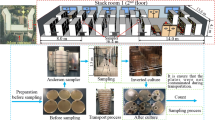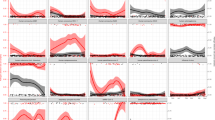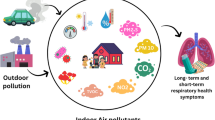Abstract
The purpose of this study was to measure concentrations of PM10 and airborne bacteria (AB) to determine how each one of them correlated with particular indoor environmental factors and characteristics of daycare centers in Seoul, South Korea.PM10 and AB were sampled in 330 daycare centers in the middle of a classroom, along with measurements of temperature and relative humidity. Spearman’s correlation and Mann-Whitney analyses were used to examine the relationship among and differences between PM10 concentration, AB concentration, indoor environmental factors, and daycare center characteristics.There were significant correlations between PM10 concentration and AB concentration (r = 0.128, p < 0.05), temperature (r = 0.153, p < 0.01), and relative humidity (r = 0.185, p < 0.01). PM10 concentrations with two or more windows; a heating, ventilation, and air conditioning (HVAC) system; and the use of air purifier were lower than concentrations with one window, window ventilation only, and no air purifier. AB concentrations were significantly higher when daycare centers had only one window and used only window ventilation (p < 0.05).Though there are many uncontrollable outdoor environmental factors that influence air quality, we demonstrated that using an HVAC system and an air purifier significantly reduces PM10 concentrations and is a practical change that could be implemented to improve the indoor air quality of daycare centers.


Similar content being viewed by others
References
Agrawal S, Kim H, Lee Y, Sohn J, Lee J, Kim Y (2010) Effect of an air cleaner with electrostatic filter on the removal of airborne house dust mite allergens. Yonsei Med J 51:918-923
American Conference of Governmental Industrial Hygienists (ACGIH) (1999) In: Macher J, Ammann HA, Milton DK, Burge HA, Morey PR (Eds.), Bioaerosols: Assessment and Control. American Conference of Governmental Industrial Hygienist, Cincinnati, Ohio
Airkorea (2016) Available at: http://www.airkorea.or.kr/
Almeida SM, Canha N, Silva A, Freitas MD, Pegas P, Alves C, Evtyugina M, Pio CA (2011) Children exposure to atmospheric particles in indoor of Lisbon primary schools. Atmos Environ 45:7594–7599
ANSI/ASHRAE (2004) Ventilation for acceptable indoor air quality, American Society of Heating, Refrigerating and Air-Conditioning Engineers, INC, 1791 Tullie Circle NE, Atlanta, GA 30329. http://isites.harvard.edu/fs/docs/icb.topic256760.files/62_1_2004.pdf. Accessed 1 March 2016
Bell ML, Ebisu K, Peng RD, Walker J, Samet JM, Zeger SL (2008) Seasonal and regional short term effects of fine particles on hospital admissions in 202 US counties, 1999–2005. Am J Epidemiol 168:1301–1310
Casati R, Scheer V, Vogt R, Benter T (2007) Measurement of nucleation and soot mode particle emission from a diesel passenger car in real world and laboratory in situ dilution. Atmos Environ 41:2125–2135
Commission of the European Communities (CEC) (1993) Indoor air quality and its impact on man, Report No. 12. 303 Biological Particles in Indoor Environment, Luxemburg: Office for Official Publications of the European Communities
FiSIAQ (Finnish Society of Indoor Air Quality and Climate) (2001) Classification of indoor climate 2000: target values, design guidance and product requirements, Espoo, Finland. http://www.irbnet.de/daten/iconda/CIB7264.pdf. Accessed 1 March 2016
Heseltine E, Rosen J (2009) WHO guidelines for indoor air quality : dampness and mould. WHO Regional Office for Europe, Copenhagen
HKEPD (Hong Kong Environmental Protection Department) (1999) Hong Kong air quality objectives, IAQ Objectives for Offices & Public Spaces. http://www.iaq.gov.hk/tables.html. Accessed 1 March 2016
Hoseinzadeh E, Samarghandie MR, Ghiasian SA, Alikhani MY, Roshanaie G (2013) Evaluation of bioaerosols in five educational hospitals wards air in Hamedan, during 2011– 2012. Jundishapur J Microbiol 6(6):e10704
Hwang SH, Park JB (2014) Comparison of culturable airborne bacteria and related environmental factors at underground subway stations between 2006 and 2013. Atmos Environ 41:2125–2135
Hwang SH, Park DU, Ha KC, Cho HW, Yoon CS (2011) Airborne bacteria concentrations and related factors at university laboratories, hospital diagnostic laboratories, and a biowaste site. J Clin Pathol 64:261–264
Hwang SH, Park WM, Ahn JK, Lee KJ, Min KB, Park JB (2016) Relationship between culturable airborne bacteria concentrations and ventilation systems in underground subway stations in Seoul South Korea. Air Qual Atmos Health 9(2):173–178
Kalogerakis N, Paschali D, Lekaditis V, Pantidou A, Eleftheriadis K, Lazaridis M (2005) Indoor air qualitydbioaerosol measurements in domestic and office premises. J Aerosol Sci 36(5):751–761
Kwon SB, Jeong W, Park D, Kim KT, Cho KH (2015) A multivariate study for characterizing particulate matter (PM10, PM2.5, and PM1) in Seoul metropolitan subway stations, Korea. J Hazard Materi 297:295–303
Langer S, Ramalho O, Derbez M, Ribéron J, Kirchner S, Mandin C (2016) Indoor environmental quality in French dwellings and building characteristics. Atmos Environ 128:82-91
Madureira J, Paciencia I, Rufo JC, Pereira C, Teixeira JP, Fernandes EO (2015) Assessment and determinants of airborne bacterial and fungal concentrations in different indoor environments: homes, child day-care centres, primary schools and elderly care centres. Atmos Environ 109:139–146
Mendell MJ, Heath GA (2005) Do indoor pollutants and thermal conditions in schools influence student performance? A critical review of the literature. Indoor Air 15:27–52
Mendell MJ, Mirer AG, Cheung K, Tong M, Douwes J (2011) Respiratory and allergic health effects of dampness, mold, and dampness-related agents: a review of the epidemiologic evidence. Environ Health Perspect 119:748–756
Ministry of Environment (2015) Indoor air quality control in public use facilities, etc. act
Ministry of Environment of Korea (2014) Indoor air quality management in public facilities. Indoor Air Quality Management Act Amendment
NIOSH Manual of Analytical Methods 0600 (1998) “Particulates not of otherwise regulated, respirable”, National Institute for Occupational Safety and Health, Education and Information Division, Cincinnati, Ohio 45226
Noraini NMR, Leman AM, Abidin ASZ, Jazar RM, Ismail R, Abdull RH (2013) Building and indoor environment: a study on three stages of a new building commisioning. IJEAS 3:63-68
Oh HJ, In-Sick Nam IS, Yun H, Kim J, Yang J, Sohn JR (2014) Characterization of indoor air quality and efficiency of air purifier in childcare centers, Korea. Buil Environ 82:203–214
Quirós-Alcalá L, Wilson S, Witherspoon N, Murray R, Perodin J, Trousdale K, Raspanti G, Sapkota A (2016) Volatile organic compounds and particulate matter in child care facilities in the District of Columbia: results from a pilot study. Environ Res 146:116–124
Ramos CA, Wolterbeek HT, Almeida SM (2014) Exposure to indoor air pollutants during physical activity in fitness centers. Buil Environ 82:349–360
Rosa AM, Ignotti E, de Souza HS, Albuquerque de Castro H (2008) Analysis of hospitalizations for respiratory diseases in Tangará da Serra. Brazil J Bras Pneumol 34:575–582
Shao L, Hu Y, Wang J, Hou C, Yang Y, Wu M (2013) Particle-induced oxidative damage of indoor PM10 from coal burning homes in the lung cancer area of Xuan Wei. China Atmos Environ 77:959–967
Statistics Korea (2015) Available at: http://www.index.go.kr/potal/main/EachDtlPageDetail.do?idx_cd=1583
Tsai MY, Liu HM (2009) Exposure to culturable airborne bioaerosols during noodle manufacturing in central Taiwan. Sci Total Environ 407:1536–1546
WHO (World Health Organization) (2013) Health effects of particulate matter: policy implications for countries in eastern Europe, Caucasus and central Asia, Regional Office for Europe, UN City, Marmorvej 51, DK–2100 Copenhagen
Yang J, Nam I, Yun H, Kim J, Oh HJ, Lee D, Jeon SM, Yoo SH, Sohn JR (2015) Characteristics of indoor air quality at urban elementary schools in Seoul, Korea: assessment of effect of surrounding environments. Atmos Pollut Res 6:1113–112
Acknowledgments
This research was supported by the Basic Science Research Program through the National Research Foundation of Korean (NRF) funded by the Ministry of Science, ICT and Future Planning (2015R1C1A1A02037363) and was supported by the Korea government (MSIP) (2016R1C1B2016366).
Author information
Authors and Affiliations
Corresponding author
Rights and permissions
About this article
Cite this article
Hwang, S.H., Kim, I.S. & Park, W.M. Concentrations of PM10 and airborne bacteria in daycare centers in Seoul relative to indoor environmental factors and daycare center characteristics. Air Qual Atmos Health 10, 139–145 (2017). https://doi.org/10.1007/s11869-016-0423-2
Received:
Accepted:
Published:
Issue Date:
DOI: https://doi.org/10.1007/s11869-016-0423-2




